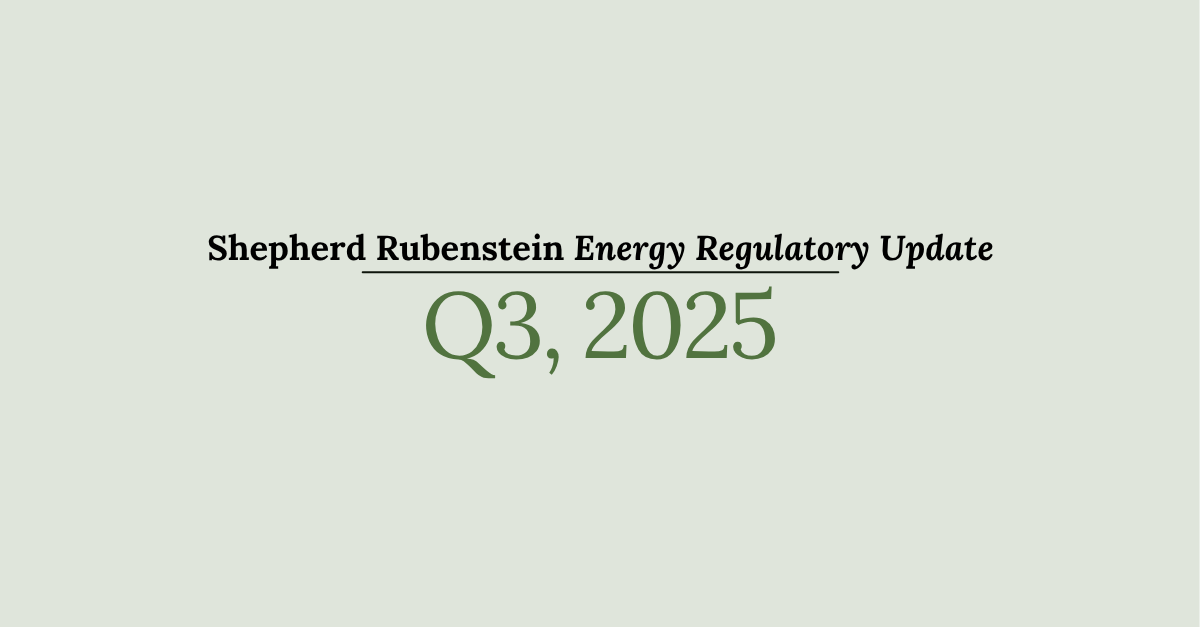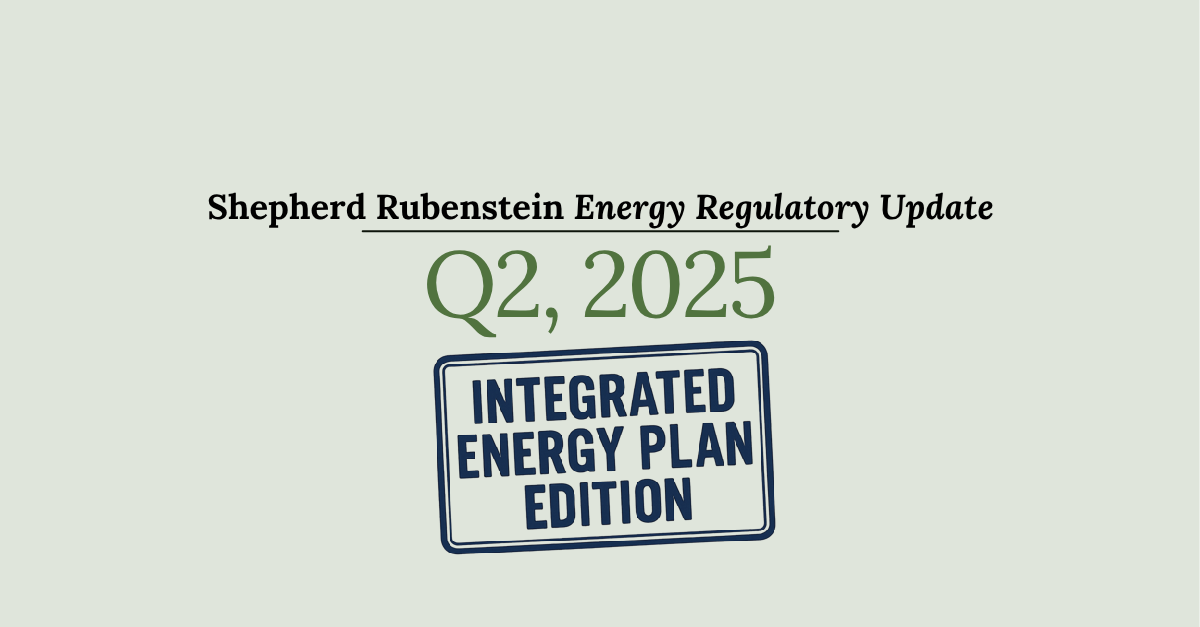Welcome to the summer edition of the Shepherd Rubenstein Energy Regulatory Update, a quarterly round-up of the important developments in the Ontario energy sector. Below are some of the key regulatory happenings between April and June. It was a very busy April, and then slower during the election and post-election period. We expect activity to pick up over the next few months.
Ontario Energy Board
The OEB issued a number of decisions, including:
- Approving the amalgamation of Kitchener-Wilmot Hydro Inc. and Waterloo North Hydro Inc., but denying approval at this time to maintain two separate rate zones for an additional 10 years after the deferred rebasing period.
- Denying Enbridge’s application for leave to construct a replacement of its St. Laurent Ottawa North Pipeline on the basis that the need for the project and the alternatives had not been appropriately assessed.
- Approving Enbridge’s Quarterly Rate Adjustment Mechanism (QRAM) application for natural gas commodity rates beginning July 1st. The Application included rate mitigation measures to address the significant increases in forecast natural gas market prices.
- Granting one part, but dismissing another, of Hydro One’s motion to review two aspects of a decision approving disposition of deferral and variance accounts of certain previously acquired utilities.
- Approving only 1 of 5 projects for which Enbridge’s had sought Incremental Capital Module (ICM)
- Approving a settlement proposal in E.L.K. Energy’s 2023 rates application which incorporated a number of unique commitments and features, including the establishment of a Reliability Commitment Account.
The Framework For Energy Innovation Work Group submitted its report to the OEB, which also included separate reports from the Benefit-Cost Analysis, Utility Incentives, and DER Integration sub-groups. (On July 6th, the OEB issued a letter inviting comments from stakeholders on the reports and next steps.)
As part of its Reliability and Power Quality Review, the OEB announced the membership and scope of work for the newly established working group.
The OEB released its report to the Minister of Energy on the design of an optional enhanced time-of-use rate price.
The Chief Commissioner issued a letter providing a year-end (2021-22) update on the OEB’s adjudicative work. The OEB also announced the membership and the commencement of work of the working group reviewing the filing requirements for 2024 for large electricity distributors.
The OEB provided its response to the Regional Planning Process Working Group (RPPAG)’s report, which provided recommendations to improve the regional planning process, endorsing all of the recommendations that require the RPPAG to take some form of action.
The Government of Ontario amended Ontario Regulation 541/05 under the Ontario Energy Board Act, to clarify and allow third-party ownership and operation of net-metered renewable energy generation. The Government also amended Ontario Regulation 389/10 under the Energy Consumer Protection Act, to provide consumer protection requirements for related agreements. As a result, the OEB proposed and then made various amendments to the Distribution System Code (DSC), Electricity Retailer Code of Conduct (ERCC), and Retail Settlement Code (RSC). It also consulted and then issued related consumer-facing materials and retail forms.
The OEB accepted Assurances of Voluntary Compliance with companies operating without generator, wholesaler, and sub-metering licenses. The OEB also released its annual Compliance Report.
Independent Electricity System Operator
The IESO released its 2022 Annual Acquisition Report (AAR). The AAR highlighted the need for additional supply to meet capacity needs in 2025 and 2026.
On the same day, the Minister of Energy wrote the IESO and requested that it:
- Initiate an engagement on potential designs to acquire further capacity and report back with recommendations by mid-July.
- Examine and report back by the of the end of July with options on cost-effective additional or expanded CDM to help address needs identified in the AAR.
- Consider accelerating the CDM Mid-Term Review.
The Minister of Energy also issued a directive to the IESO to, i) enter into a procurement contract with Oneida Energy Storage LP for its proposed 250 MW Oneida Battery Storage project, and ii) waive an available off-ramp to the Bruce Power refurbishment agreement.
The IESO undertook various procurement engagement activities, including, its Long-Term RFQ and RFP, and the development of a new program for re-contracting small hydro facilities, The IESO is also evaluating the submissions made to its Medium-Term RFP, which closed in April.
As part of its Hybrid Integration Project engagement, the IESO published the design document for Enabling Foundational Hybrid Facility Models for review.
With respect to the Market Renewal Program (MRP), the IESO revealed that there will be a delay in the November 2023 in-service date and a revised schedule expected to be shared by the end of Q3, 2022.
The Technical Panel held three meetings during the quarter where it recommended market rules amendments related to the replacement of the IESO settlement system, improving awareness of system conditions, and accessibility of operating reserve. All three were adopted by the IESO’s Board of Directors. In contrast, it did not recommend proposed amendments related to the 2022 Capacity Auction which would introduce a capacity qualification process (shift requirements from ICAP to UCAP), performance assessment modifications, and expand participation of generator backed capacity imports.
The IESO issued a number of significant reports, including:
- Update on the Status of Obstacles to Storage Resources in Ontario Report, prepared at the request of the Minister of Energy.
- The Q2 2022 Reliability Outlook
- South Georgian Bay/Muskoka Integrated Regional Resource Plan (IRRP) reports, (Barrie/Innisfil Integrated sub-region IRRP, and Parry Sound/Muskoka sub-region IRRP)
- An Updated Needs Assessment and Timing for Waasigan Transmission Line
Comments were sought regarding IESO’s reconsideration of existing Market Rules exemptions provided to certain steel producers related to the participation in the energy and operating reserve markets, as well as Hydro One’s request for an exemption from certain ORTAC requirements related to new load to be connected to one of its transmission stations.
The IESO launched the Industrial Energy Efficiency Program.
The Market Assessment and Compliance Division (MACD) entered into a settlement agreement with Ontario Power Generation with respect to two events in 2016, alleging OPG had failed to sufficiently plan and coordinate scheduled outages involving certain control equipment or to recognize the purpose and limitations of the associated electrical protective relay scheme contrary to the Market Rules.
The IESO signed an updated Memorandum of Understanding with the Ministry of Energy.
Legislative and Regulatory
The Minister of Energy announced the launch of the Electrification and Energy Transition Panel. The panel, to be chaired by David Collie, is tasked with providing advice on how to coordinate long-term energy planning, in the context of growing energy demand, new technologies, low-carbon fuel switching, and the need for sustainability and affordability.
There were a number of significant developments with respect to the promotion of hydrogen:
- The Government of Ontario released its Low-Carbon Hydrogen Strategy.
- As a follow-up, the Minister of Energy wrote the IESO and asked it to investigate and propose program options to integrate low-carbon hydrogen technologies into the electricity grid, and report back by October 31, 2022.
- The Ministry of Energy also issued for comment three proposed options to promote the use of hydrogen, including i) allowing certain hydrogen producers to be eligible to qualify for the Industrial Conservation Initiative (ICI), ii) co-locate hydrogen electrolysis at electricity generation facilities, and iii) create a dedicated stream for hydrogen producers as part of its interruptible rate pilot currently under development.
Government of Ontario issued a number of new regulations and amendments to existing regulations, including:
- Amending Ontario Regulation 124/99 and Ontario Regulation 162/01 under the Electricity Act, extending Municipal Electricity Utilities transfer tax relief, and Payment in Lieu of Corporate Taxes (PILs) relief upon a change in tax status, from January 1, 2023 to January 1, 2025.
- Issuing Ontario Regulation 410/22 under the Ontario Energy Board Act, prescribing certain requirements when a distributor receives notice regarding a designated broadband project in its service territory, including timelines for development, access, and use, of infrastructure, default rules regarding appointment of costs, authority of the OEB to resolve disputes, and establishment of a deferral account for designated broad band projects (On July 7th, the OEB issued an Accounting Order for the deferral account).
- As discussed earlier, amending Ontario Regulation 541/05 under the Ontario Energy Board Act and Ontario Regulation 389/10 under the Energy Consumer Protection Act, to allow third-party ownership and operation of net-metered renewable energy generation.
- Amending Ontario Regulation 429/04 under the Electricity Act, aimed at reducing regulatory burden with respect to the Industrial Conservation Initiative (ICI), including among others, i) changing that the five peak hours will be determined based on real-time Ontario demand, ii) changes to address partial changes of ownership, iii) LDCs will now administer transfers of ownership, and iv) various other administrative changes.
Judicial Decisions
The Ontario Superior Court of Justice released its decision in National Steel Car Ltd. v. Independent Electricity System Operator, dismissing an application challenging the constitutionality of portions of the Global Adjustment, that recover costs related to the Feed-in-Tariff Program, as an unconstitutional tax. National Steel Car argued that the Government’s real purpose in creating the FIT programs was economic stimulus, and thus it was a colorable attempt to tax through regulation, contrary to sections 53 and 54 of the Constitution Act, 1867, which requires taxes to be authorized by the legislature. The Court dismissed the application finding the Global Adjustment, including the portions recovering the costs of the FIT program, are a valid regulatory charge, and not a tax. It also found that the FIT programs were not a colorable attempt at taxation, and that given the importance of energy to the economy, the pursuit of economic stimulus can be related to a regulatory scheme about energy, and in this case, was related to electricity regulation.
Things We Are Reading
FERC’s Notice of Proposed Rulemaking regarding transmission planning and cost allocation.
There were many reports released by a range of organizations over the past few months regarding the role of electricity in reaching net-zero, including from the Canadian Climate Institute, Electrifying Canada, Electricity Canada and Canadian Gas Association, and the David Suzuki Foundation.


